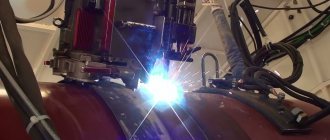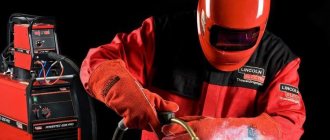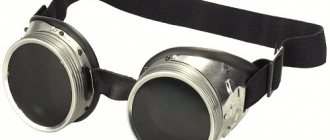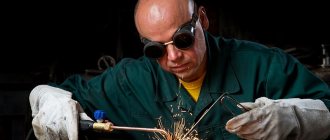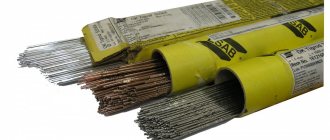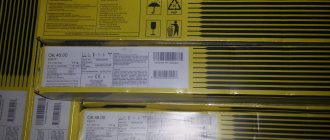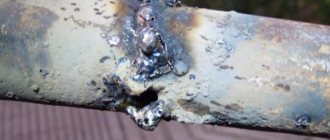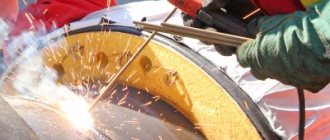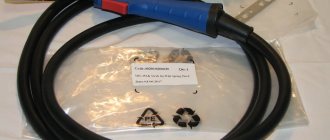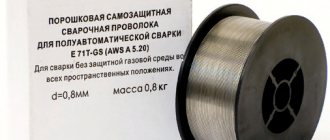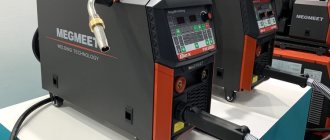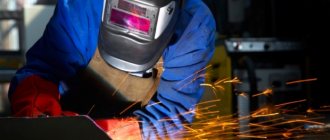07/23/2019 Author: VT-METALL
Issues discussed in the material:
- What is the semi-automatic device intended for and what does it consist of?
- What are the pros and cons of semi-automatic welding
- What are the main types of semi-automatic welding?
- What are the subtleties of semi-automatic gas-shielded and submerged arc welding?
- What to consider when choosing equipment for semi-automatic welding
Semi-automatic welding is a partially mechanized process. Unlike manual arc welding, which uses replaceable stick electrodes, part of the work is performed by a machine. Semi-automatic technology also differs from fully automated technology, which occurs without human intervention. In this article we will describe what types of semi-automatic welding exist, its advantages and disadvantages, as well as possible nuances of work.
Classification of welding machines
There is a wide variety of semi-automatic machines on the welding equipment market. They are classified according to various criteria.
By type:
- professional;
- semi-professional;
- household
By method of movement:
By nature of protection:
- in protective gases (active, inert, active and inert);
- with cored wire;
- under a layer of flux.
According to the type of electrode wire, welding is carried out:
- aluminum wire;
- steel wire;
- universal wire.
By way of eating:
By wire feed type:
- pulling look;
- pushing look;
- push-pull type.
By performance category:
- single-hull;
- from several parts.
Each model has adjustable wire feed speed and welding voltage. The adjustment can be stepwise, smooth or stepless. For some devices, the feed speed depends on the voltage.
Operating principles of semi-automatic machines
Electrode wire is continuously fed to the area prepared for welding. Heating occurs, and the surface being treated is deformed during the welding process. An electrical discharge occurs between the metal and the electrode, which is energized, in a mixture of vapors and gases. The inert gas prevents the formation of oxides, resulting in better weld quality.
Whether to use a welding technique with or without shielding gas depends on the type of model the specialist is using.
The device has two poles, one of which is positive, the other negative. The choice of direct or reverse polarity will depend on the material being welded. One clamp is attached to the torch tip, the other to the workpiece.
Power to the handpiece is supplied from the main unit. The current strength is selected in accordance with the characteristics of the metal being processed. The feed speed is set using a gear or gearbox.
Gas semi-automatic machines operate with inert or carbon dioxide. Welding wire containing silicon and magnesium is melted and supplied to the area to be welded. The metal workpiece and electrode are protected from the negative effects of oxygen by gas, which is supplied simultaneously with the welding wire.
Gas is not used for models working with flux-cored wire. In terms of its structure, flux is a powdery composition that is found in the core of various types of wire. During operation of the device, the flux burns, and the resulting gas neutralizes the harmful effects of oxygen.
Semi-automatic welding machine without gas
Welding in this way occurs using a flux wire containing a special welding powder. In appearance, welding with gas and without gas are similar due to the combustion of flux with the formation of a cloud of gas.
The main advantage of this type of welding is the absence of cylinders that are under gas pressure. The wire for work can be made of any material, it all depends on the metal being welded. After applying one seam, it is necessary to make another one on top, because due to the flux, slag can get onto the seam. After this, additional processing may be required.
Semi-automatic welding machine without gas
Working with such welding is a little more difficult: the wire must be fed into the welding area with force, and throughout the entire work you need to monitor the bends of the hoses, the polarity and the phase of the operation.
Device design
To master the operating principle of a semi-automatic machine, you need to study its structure. Despite the differences, all models have a similar design. It consists of the following components:
- main block;
- shielding gas cylinder;
- power cable 220 V/ 380 V;
- mass clamp;
- welding sleeve;
- burner;
- nozzle;
- welding wire;
- control panel;
- gearbox
A semi-automatic welding machine, divided into several parts, has a torch and main control in one block, and a power source with control in the other.
Cost of semi-automatic welding machine
The price of an automatic welding machine depends on many factors. The simplest option can be purchased for $200. For a home, the cost of the most expensive device will be $400. But professional equipment for welding will cost $1500-5000.
To use the semi-automatic welding machine correctly, you must study all the instructions and follow simple safety rules. To begin with, you should learn how to cook simple elements, and with experience move on to more complex designs.
How to choose a semi-automatic welding machine: types, characteristics, cost
tools how to choose semi-automatic welding
Welding modes
This type of welding makes it possible to set the settings yourself. You can change the following parameters:
- seam height;
- wire feeding;
- melting rate;
- electrode movement.
Welding torches are adjusted taking into account GOST and metal thickness. The use of gas reduces the heat affected area. This makes it possible to apply several seams to the metal without defects.
The following welding modes are distinguished:
- pulse;
- cyclical;
- point;
- jet movement;
- circular movement.
As required by state standards, an inert gas is used - helium, argon or a mixture of these gases. Carbon dioxide is used when working with low-alloy steels. Correct use of gas improves the quality of the weld and protects the welder from injury and burns.
Semi-automatic welding machine for cars
A simple welding machine with a voltage of 220 V is suitable for car repairs. For more in-depth work with the machine, a powerful welding machine with 380 V is required. In this case, the welding seam will be much better and stronger.
A device with a mixture of argon and carbon dioxide in a ratio of 80 to 20 will help you get an even seam without splashes. You need to choose a manufacturer from leading European manufacturers; the investment will pay off for many years.
The switching duration must be selected at least 50%, and the power must be at least 150 A. Depending on the work, a choice must be made between mechanical and electrical wire feeding.
Work order
After identifying the welding object, it is necessary to carry out preparatory measures:
- Select wire for the device in accordance with GOST.
- Select a burner with the required power.
- Set up a semi-automatic welding machine.
- Select the type of seam in accordance with GOST.
- Degrease and clean the surfaces to be welded.
- Make a test seam to determine the accuracy of the settings.
- Select the voltage and current.
The device can weld both thin sheets of metal 0.5 mm and thick ones up to 40 mm, but for this you need to know welding methods:
- A connection made with a spot or continuous seam is called butt welding. This method is often used at car service stations.
- The overlap method involves spot welding a sheet of metal onto a prepared surface.
- Connection through prepared holes is carried out by welding the workpiece to the prepared surface.
Rating of welding machines
A variety of welding technologies and methods are presented on the market by a large number of different models of semi-automatic welding machines. You need to know the characteristics of the device and user reviews in order to choose the right device.
For efficient work, it is better to purchase models with several operating modes and support for manual arc welding.
Read also: Steel for combat knives
It is necessary to pay attention to the electrical network in which the device can operate.
It is necessary to clarify the current and power. The current strength determines how thick sheets of metal the device can weld, and the power will affect the duration of continuous operation:
- One of the best models from a Russian manufacturer can be called the inverter-type semi-automatic welding machine Svarog REAL MIG 200 (No. 24002). This is a durable and powerful device that welds in both arc welding and semi-automatic modes. The device is equipped with regulators for wire feed and current settings. Svarog produces neat and even seams, the ventilation system protects against overheating. The manufacturer has established a warranty period of five years. The low price of 20 thousand rubles corresponds to the good quality of the device.
- The inexpensive inverter semiautomatic welding machine Aurora also has good technical parameters. It is used for aluminum welding and can operate either from a generator or from the mains. It has a button for drawing the wire, the inductance is adjustable. At reduced voltage, the welding is stable and the formation of metal spatter is minimal. The average cost of the Aurora model is also 20 thousand rubles.
- The semi-automatic household wire welding machine on the market is represented by the Resanta . Its price segment is up to 15 thousand rubles. Despite the budget price, it has good technical parameters. Resanta differs from other models in its light weight. Welding can be carried out both with and without gas. The device is equipped with electronic control with an overheating protection system.
Characteristics of semi-automatic welding machine
The semi-automatic welding machine is designed to perform arc welding using an electrode in a protective environment. With the help of such welding it is possible to make jewelry work on very thin metals. Rust protection and seam quality with such equipment increases several times, and work productivity increases.
One good welding machine should include:
- current source for welding - rectifier or inverter;
- mechanism feeding welding wire;
- welding torch;
- wires and cables that are needed to connect to the electrical network;
- package of welding cables – with holder and clamp;
- a sleeve for connecting protective gas to the source;
- a cylinder with gas for protection - carbon dioxide, argon or helium;
- terminal for controlling equipment with regulating and control equipment.
Set of semi-automatic welding machine
The most important characteristics of the semi-automatic welding machine are:
- Maximum current. This parameter affects the diameter of the wire used and the maximum thickness of the metal being welded. In the technical document, the manufacturer indicates the required current to work with any material.
- Network settings. Depending on the voltage, you can use more powerful devices with additional capabilities and functions. For normal use at home, a voltage of 220 V is sufficient.
- Duration of switching on. This characteristic shows how long the semi-automatic welding machine can work continuously. The higher this parameter, the longer the device can operate. For domestic conditions, 30% is enough, and for professional models – at least 60%.
Semi-automatic welding circuit diagram
The performance of the equipment fully corresponds to the power consumption. The magnitude of the no-load voltage is different on the models of semi-automatic welding machine. The output current range for all modes is indicated separately. The weight of the device and its dimensions do not greatly affect the device.
Safety precautions during operation
All manufacturers describe the operating and safety rules of the device in their instructions. Compliance with these rules will ensure uninterrupted and safe operation of the semi-automatic welding machine. The use of additional protective equipment will protect the welder from phenomena such as ultraviolet radiation, splashing of molten metal and others.
Fire safety rules and electrical installations must be observed at the workplace. If welding is carried out indoors, it must be regularly ventilated.
Do not point burners at people. Their condition must be monitored and cleaned in a timely manner.
The equipment must be stored in a dry place. Every six months you need to carry out a scheduled inspection, cleaning, and repair of the device if necessary.
Responsibility for the operation of the equipment lies with the specialist working on it. He is obliged to strictly observe the given regime, use the installation strictly for its intended purpose, and observe safety precautions.
For protection during work, the welder must be provided with protective devices, namely: knee pads, sleeves, a balaclava, an apron, mittens, special shoes, and a dielectric mat. Protective shields with light filters are manufactured in accordance with GOST. Light filters depend on the type of welding. Clothing should be dry and clean, dark in color and made from 100% flame retardant cotton or wool.
If it is impossible to ensure clean air in the welding work area, respiratory protection must be used.
The demand for semi-automatic welding machines in the welding equipment market continues to grow every year. This is due to their obvious advantages: affordable cost, wide range of operating modes, ease of setup and operation. However, it is not always possible for a novice master to figure out how to use a semi-automatic machine correctly. The first thing you need to know is the structure and operating principle of the unit, as well as basic recommendations for choosing wire for welding.
Design and principle of operation of a semi-automatic device
The main purpose of a semi-automatic welding machine is arc welding using a consumable electrode, which is blown with shielding gas . The device is used for joining low-alloy and low-carbon steels, both with extended and intermittent seams.
This equipment is intended for operation in closed, well-ventilated rooms at air temperatures from -10°C to +40°C.
The semi-automatic device consists of the following elements:
- the main unit that generates the welding current of the required value;
- wire feed unit;
- welding torch with a connected cable, through which passes the power wire, gas hose, control wire and guide for the wire electrode.
The operating principle of the unit is as follows. When you press the start button located on the torch handle, the flow of electrode wire (4), current and shielding gas through the nozzle (2) begins. Current flows to the wire through the conductive tip (4). When it comes into contact with the base metal, an electric arc occurs, which begins to melt the electrode. Drops of electrode metal, falling on the base metal (8), form a seam (6). In this case, the weld pool (7) is blown with shielding gas (10), which prevents oxygen and nitrogen from entering it from the atmospheric air. Thanks to gas protection, the weld is strong and of high quality.
The operation of the semi-automatic device is possible without protective gas. In this case, electrode wire with a special powder coating is used. At high temperatures, this coating evaporates, and the resulting gases perform a protective function for the weld pool.
Semiautomatic welding machine for home
To select a semi-automatic welding machine, you need to decide how this device will be used. There is no point in purchasing expensive professional equipment for your home, so you should focus on household and semi-professional ones. Household devices are perfect for similar and simple work with the same metals. The second type of semi-automatic machine will fit well with people who carry out operations with materials of different structure and thickness.
Welding current is of great importance. You need to immediately decide what thickness of metal you will have to work with. Current to thickness ratio:
- up to 50 A – 1.5 mm;
- up to 80 A – 2 mm;
- up to 130 A – 3 mm;
- up to 160 A – 4 mm;
- up to 180 A – 5 mm.
These are average values; the exact value must be determined for a specific metal. It must be taken into account that the device should not operate at maximum power, because it can quickly fail. It is best to take a semi-automatic welding machine with a small reserve. If neat seams are required, then when choosing a device for your home you should pay attention to current regulation.
Supply voltage is one of the most important issues for welding work. For home operations, equipment with a single-phase connection is ideal. But very often there are power surges in the network, due to which electricity can be lost. Therefore, it is necessary to look at deviations at face value. If jumps are frequent, then the deviation should be as large as possible.
If finances allow you to take a more expensive model, then you should take an inverter semi-automatic machine. It has additional functions, current regulation and arc stability.
Electrode wire selection
Electrode wire is an accessory without which the welding machine cannot operate. It is supplied using a special mechanism and performs the function of an electrode.
For semi-automatic machines there are two groups of materials for welding:
- solid wire;
- flux cored electrode wire.
There are more than 76 varieties of the first option. But most often, only a small part of them is used. The remaining types of equipment are highly specialized and are used in production. The main thing to consider when choosing wire is the type of metal from which the structure will be welded. Most often, you have to automatically weld low-carbon and low-alloy steels using non-copper-plated and copper-plated wire.
Read also: Kinematic diagram of a planetary gearbox
Copper-clad wire is the most popular among welders due to its anti-corrosion coating. But not everyone knows that when copper is smelted, harmful fumes are released into the air. Non-copper-plated wire is more harmless and has a corrosion-protective coating.
Semi-automatic machines also use flux-cored wire, which does not require protective gas during cooking. The electrode wire has a special marking, for example, this: SV-08G2S . It is deciphered as follows:
- SV – welded wire;
- 08 – means that the mass fraction of carbon in the composition of the equipment is 0.08%;
- G – this letter denotes manganese, which is contained in the wire;
- 2 – the number indicates that the manganese content is 2%;
- C – this letter indicates the presence of silicon in the equipment; if there is no number after the letter, then it contains no more than 1%.
The following is a table in which the letter designations of all additives included in the composition of the welding wire are deciphered.
For example, using the table, you can decipher the marking SV-06Х21Н7БТ, which means: welding wire has 0.06% carbon, 21% chromium, and nickel - 7%; the wire is alloyed with two metals, niobium and titanium.
For welding low-alloy steels (this is 90% of all rolled metal), 08G2S wire with a diameter of 0.6 mm is used. It can be used both at home and for body repairs. In addition, it can be used on units with current up to 500A. For welding stainless steels, wire of the S01X19N9 grade is used. Aluminum and copper are boiled in an argon atmosphere corresponding to the composition of the wire. Aluminum is welded by grades SV-97, SV-A85 and SV-AMts. For copper welding, equipment of the SV-97, SV-A85 and SV-AMts brands is used.
The diameter of the electrode wire is selected in accordance with the thickness of the metal being welded.
Tips for choosing a semi-automatic welding machine
Before purchasing a device you need:
- Determine through which electrical network the work will be carried out.
- Find out what type of operations will be performed on this device.
- Learn how the welding process occurs using a semi-automatic machine.
- Pay attention to the manufacturer, reviews about working with him.
The quality of seams will be 1.5-2 times higher if you use foreign equipment. But their price exceeds the cost of domestic ones. It is important to determine what is most important to you personally.
Semi-automatic welding rules
First of all, when starting to work with a semi-automatic machine, the parts intended for connection must be well cleaned of paint and rust. You should also clean the area where the mass clamp will be attached.
How to hold the burner
You can hold the torch with one hand, but the quality of the seam will be better if you use both. One hand serves as a support, and the other holds the burner.
With this method, it is easier to control the angle and distance of the torch from the workpiece, as well as carry out the necessary movements to form a high-quality seam. To keep your hands free, you need to use a welding mask that is attached to your head.
There is no ideal angle when working with a semi-automatic machine. Typically, to connect workpieces lying in the same plane, a torch tilt (from the vertical position) of 15-20 degrees is used. When connecting parts that are at an angle to each other, a burner tilt of 45° is used. Each welder, with experience, selects the most convenient angle of inclination of the tool, taking into account various situations.
Torch movements
To form a high-quality seam, there are many ways to move the torch.
- For metals with a thickness of 1-2 mm, a wavy-zigzag movement is used. Thus, the arc captures both sheets of metal and does not have time to burn through it. As a result, the seam is tight and durable.
- For welding metals of any thickness, a straight seam is used, eliminating any sideways movements. But in this case, the operator is required to have some experience so that when moving the torch, the arc evenly affects both mating parts.
- If you are going to work on metal with a thickness of less than 1 mm, then you should reduce the current strength and wire feed speed, and also use wire of a smaller diameter. Welding should occur in short pulses, with a pause between them of about 1 second. A pause is needed to cool the metal and merge the next segments into a monolithic seam.
- If long, thin parts are mated, then welding is carried out in short segments or points located at a certain distance. Also, to avoid deformation of parts, you can cook alternately, in short segments, from different ends of the mating segment.
Welding speed
This is the speed of movement of the electric arc along the joint of the parts, and it is controlled by the operator of the semi-automatic machine. The speed of the tool must correspond to the arc voltage, wire feed speed, metal thickness and the required weld shape. At a high speed of movement of the torch, a lot of splashes are generated, the protective gas remains in the quickly solidifying seam and causes the formation of pores in it. When the torch moves at a slow speed, excessive exposure of the electric arc to the material is formed, which can burn through it. In addition, when connecting massive parts, a thick seam is formed. The following figure shows what the seams look like at different torch speeds.
Gas flow rate
The gas supply must be sufficient to provide airflow to the fed wire. If the gas flow is weak, the seam will not be protected from oxidation. But even at high flow speeds, protection will be insufficient due to the occurrence of turbulence. All these deviations from the norm make the seam porous and fragile. Therefore, it is very important to achieve an even supply of gas so that the flow does not cause turbulence and fully protects the welding site.
Wire output length
The wire should extend 6-13 mm from the tip before it touches the metal. The resistance and temperature of a given section of the electrode depend on this value. The more the wire extends from the tip, the smaller the arc size will be. As a result, the seam will be thick and narrow, with low penetration into the metal. If the length of the tool exit is reduced, the penetration of the arc into the metal will increase, and the seam will become thinner and wider.
Read also: White and blue wire where is the plus
Polarity
Polarity in welding equipment refers to the direction of current in its circuit. With direct polarity, a negative charge is applied to the wire, and a positive charge is applied to the part being welded. With reverse polarity, the opposite is true: the wire is positive, and the workpiece is negative.
Important! When working without protective gas, flux-cored wire, the direct polarity method is used, and with gas, reverse polarity is used.
Welding sound
Listening to welding sounds is important, especially for beginners when learning. The correct sound when welding with a semi-automatic machine resembles the sound of meat frying in a frying pan. When a “hissing-buzzing” sound is heard, it means that the balance has been achieved between the current settings, wire feed speed and gas. Changes in sound during operation of the device may be affected by:
- poor contact between the mass clamp and the part;
- the presence of frozen splashes on the burner tip, preventing the normal flow of gas;
- welding area poorly cleared of rust or paint.
How to use a semi-automatic
The use of a semi-automatic machine directly depends on the welding technology you choose. If you cook in a gas environment, then the application will be the same. But if you cook with flux-cored wire, then it will be completely different. Here we will talk about the main nuances of application that are inherent in all semi-automatic devices.
To achieve high-quality seams, a semi-automatic welding machine must be correctly configured or select a welding mode. Start by selecting the welding current. It should be selected based on the parameters of the part being welded. Many manufacturers indicate in the instructions for the semi-automatic machine a special table of the ratio of metal thickness and current strength. Use it if you are a beginner.
Also keep in mind that semi-automatic machines are not able to form a high-quality connection at extremely low current values. If you are afraid of burns, you can set the minimum current and start welding, gradually turning the regulator and increasing the value to the required level. Don't forget about the voltage, it also needs to be adjusted. Now about wire filler materials. The spool of wire must be placed in the feed unit of the semi-automatic machine. If your semi-automatic machine is not equipped with this unit, you can purchase it separately and connect it to the device. The semi-automatic machine comes with replaceable gears, with the help of which the wire feed speed is adjusted. When selecting speed, take into account your welding skills. If you have just learned the basics of welding, do not set the feed speed too fast, otherwise you will not be able to form a seam.
Further actions depend on the welding technology you have chosen and should be considered individually. Within the framework of this article, we will not be able to reveal all the nuances of each type of welding using a semi-automatic machine. Therefore, we recommend that you read the rest of the articles on our website.
Always check the correct welding mode you have selected on the unwanted part or workpiece. This way you can avoid many mistakes and adjust some settings if necessary.
Safety precautions when working
When working with welding equipment, the following safety precautions must be observed.
- The welder must protect all areas of the body from splashes of hot metal. For this purpose, special clothing is used that tightly covers exposed areas of the body, as well as protective gloves. Clothing should be made of dense material that can withstand hot splashes. Under no circumstances should clothing be made from synthetic fibers, which begin to melt when exposed to high temperatures. Such material burns through instantly, which can cause burns to the welder.
- Since welding produces hard ultraviolet radiation, it is necessary to protect your eyes from it using a mask with tinted glass. Not long ago, masks with chameleon glass, which darkens when exposed to bright light, appeared on sale. Other areas of the body should also be protected from ultraviolet radiation.
- Shoes must be closed to prevent hot splashes from getting into them.
- The room where welding work is carried out must have forced or natural ventilation (the presence of windows that can be opened). Inhalation of vapors and smoke generated during the welding process has a detrimental effect on human health.
In semi-automatic welding, a special wire is used as an electrode necessary to form a welding arc that ensures melting of the metal. It is also a filler material, forming the deposited weld metal. Before feeding the wire, during the process and some time after extinguishing the arc, active or inert gas is supplied to the welding zone through the torch nozzle. It displaces the oxygen-containing atmosphere, thereby protecting the weld pool and preventing oxidation of the metal until crystallization. If the so-called flux-cored (flux-cored) wire is used, protection is provided by a gaseous medium, which is formed as a result of melting of the powder (flux) inside the wire.
MIG/MAG welding is one of the most high-tech manual welding methods, allowing to obtain high-quality connections of products and structures from dissimilar metals with a thickness of 0.5 mm. Uniform supply of filler material and reliable protection of the weld pool make it possible to obtain a perfect seam even in the absence of much experience and skill on the part of the welder.
It is perfect for welding all types of metals, and primarily metal products of small thickness, when a large penetration depth is not required. In particular, semi-automatic welding is often used for welding vehicle body parts, as well as for similar work in service workshops and in production.
Advantages of semi-automatic welding:
- High productivity, thanks to mechanized electrode supply, and fast ignition of the arc.
- Excellent quality of the weld and reliability of the connection due to the use of shielding gas.
- There is no need to frequently change the electrode and manually feed it into the welding zone.
- Possibility of joining products of small thickness from most metals, including difficult-to-weld ones.
- Insignificant influence of the welder’s qualifications on the result of the process.
Disadvantages of semi-automatic welding:
- The need to include gas cylinders in the equipment reduces its mobility.
- Limited burner length (up to 5 meters).
- Small depth of penetration of the base metal.
Welding machines for semi-automatic welding
For semi-automatic welding, special power sources are used, mainly of the inverter type. An invariable element of equipment for MIG/MAG welding is the wire feeder (feeder). In devices up to 300A, it is usually placed in the same housing with the current source. The feeder for heavier and more powerful semi-automatic welding machines, as a rule, is supplied in a separate housing. In the latter case, during work on the site, it is enough to move only the wire feed mechanism, while the bulky and heavy power source remains in place. The control cable connecting it to the feeding device can be up to 50 meters long, which, if necessary, allows you to place the device under a canopy to protect it from precipitation.
MIG/MAG welding machines generate only direct current, so both inverters and rectifiers are used as sources. Important characteristics of the devices are the presence of a four-stroke operating mode of the torch and the possibility of its water cooling for constant operation at high welding currents. Some devices provide the ability to connect a remote control panel and program welding modes using synergy.
Semi-automatic welding machine with gas
Welding various products made of copper, titanium or steel with a welding machine is the process of combining parts of metal by feeding wire to the joint. Along with this process, shielding gas is supplied. This gas ensures that the air does not negatively affect the heated and molten metal.
Welding using shielding gas does not require the additional purchase of expensive equipment. An even greater advantage is that work with carbon dioxide can be done anywhere without installing a special energy source.
When welding with gas, you can easily change the flame power to join different materials that have different melting points. Cast iron, copper, lead and brass weld much better, faster and stronger with this type of welding. If all rules and instructions are followed, the seams will be of the highest quality.
This type of welding can not only weld, but also cut and harden various metals. Welding can take place in an environment of argon, carbon dioxide or other inert gas. Special wire for welding with gas contains manganese and silicon, which protect against the negative effects of the external environment.
Saving time with this type of welding is easy because the electrodes do not need to be changed and the seams do not need to be cleaned after welding. When using pure carbon dioxide, the seam will have a scaly texture, and when adding argon, the seam will be smooth and even.
